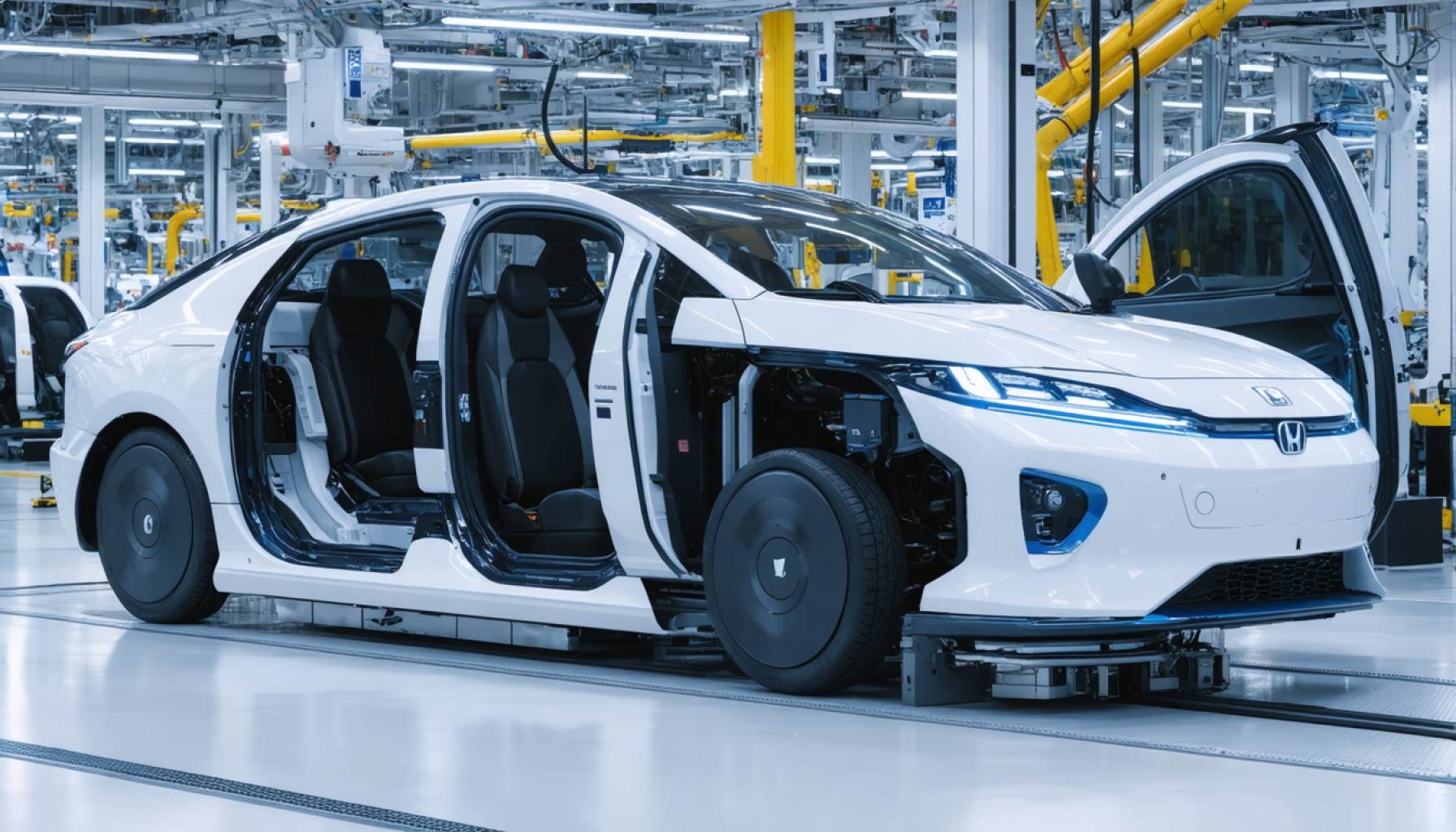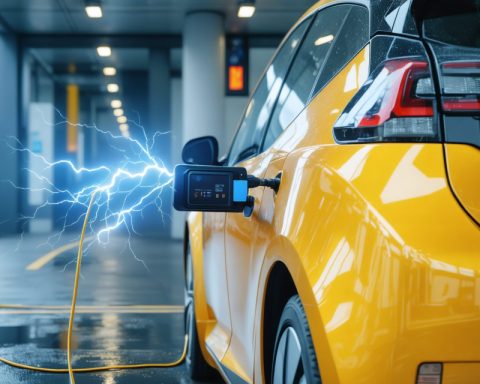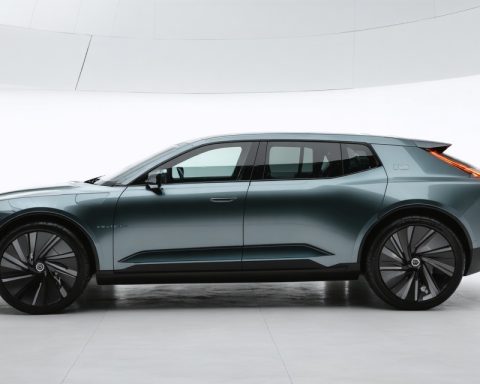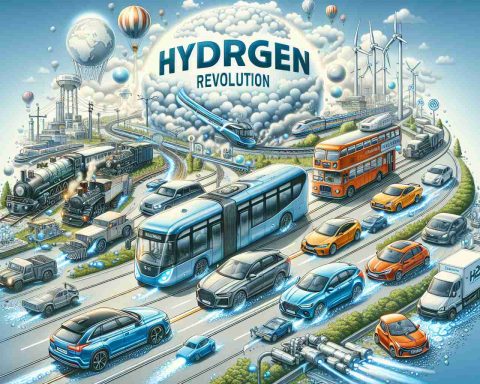- Honda unveils a state-of-the-art EV factory in Guangzhou, symbolizing its strategic shift towards electric vehicles and marking a departure from its petrol-heavy past.
- The GAC Honda Automobile venture in Guangzhou boasts an annual capacity of 120,000 vehicles, emphasizing Honda’s commitment to expanding its EV presence.
- Advanced robotics and AI significantly reduce manpower by 30% and enhance production efficiency, underscoring Honda’s focus on automation and sustainability.
- Honda’s strategy is pivotal as it competes against local giants like BYD in a rapidly growing EV market driven by tech players such as Huawei and Xiaomi.
- The launch of Honda’s new EV model, the P7, highlights its adaptability and dedication to electrification amidst a transforming automotive landscape.
Amidst the sprawling industrial landscape of Guangzhou, a new beacon of automotive innovation emerges: Honda’s cutting-edge electric vehicle (EV) factory. This is no ordinary assembly line; it’s a symphony of robotics and artificial intelligence, tailored to finesse and accelerate the production of Honda’s latest EV lineup. The shimmer of steel and the methodical dance of machines paint a vivid picture of the future—a meticulous orchestration of man and machine, transforming raw material into the vehicular marvels of tomorrow.
The Guangzhou factory, a venture of the joint operation “GAC Honda Automobile,” began its journey in earnest last December. With an impressive annual capacity of 120,000 vehicles, this facility symbolizes Honda’s aggressive push into the EV domain, marking a decisive shift from its petrol-dominated past. Together with another burgeoning factory, operational since September of the previous year, these sites are set to become the twin pillars of Honda’s EV strategy—a strategy that is crucial in a market where local titans like BYD drive fierce competition.
A remarkable 30% reduction in manpower is achieved here, thanks to the seamless incorporation of robots in welding processes and a holistic AI inspection system that ensures top-notch quality. Everything from component handling to quality assurance is driven by technology, highlighting Honda’s commitment to efficiency and sustainability. Gone are the days of labor-intensive production; this is the dawn of autonomous, intelligent manufacturing.
China’s appetite for EVs and “new energy vehicles” has skyrocketed, fueled by tech giants like Huawei and Xiaomi ambitiously stepping onto the automotive stage. Honda finds itself navigating this rapidly evolving landscape, where traditional fuel vehicles are no longer the toast of the town. Against this backdrop of innovation and competition, Honda’s unveiling of its brand-new EV model, the P7, marks a significant milestone—a testament to its resilience and adaptability.
The key takeaway from Honda’s strategic pivot is clear: embracing advanced technology is not just an option but a necessity in today’s shifting automotive ecosphere. As challengers from unexpected corners join the fray, the automotive giants must innovate to stay ahead. Honda’s Guangzhou factory epitomizes this vision—a future where intelligent machines breathe new life into an age-old industry, driving forward the company’s pledge to electrification, sustainability, and market leadership.
Unveiling Honda’s High-Tech EV Factory: What You Need to Know About the Future of Automotive Manufacturing
Introduction
In the bustling industrial hub of Guangzhou, Honda’s new electric vehicle (EV) factory stands as a symbol of innovation and modernization. This advanced facility not only signifies Honda’s aggressive move into the EV market but also showcases the future of automotive manufacturing. Here, a synergy of robotics and artificial intelligence (AI) redefines car production, promising efficiency, sustainability, and a stronger foothold in the competitive EV landscape.
An Inside Look at Honda’s Guangzhou EV Factory
1. Cutting-Edge Technology and Automation:
– The factory reduces manpower requirements by 30% through extensive use of robotics and AI. Robots handle welding processes with precision, while an AI inspection system ensures the highest quality standards. This aligns with the global trend of automating labor-intensive tasks to cut costs and increase production speed.
– AI-driven systems streamline component handling and quality assurance, creating a seamless production process. As factories incorporate more AI, they promise reduced error rates and enhanced product quality.
2. Honda’s Strategic Shift Toward Electrification:
– The Guangzhou facility, capable of producing 120,000 vehicles annually, highlights Honda’s ambitious push into the EV sector. By prioritizing electrification, Honda is reducing its dependence on traditional fuel vehicles to align with global environmental goals and consumer preferences.
– This investment is part of Honda’s broader strategy to capture market share in the rapidly growing EV market, where competitors like BYD and tech companies such as Huawei and Xiaomi are making significant strides.
3. The Rise of EV and New Energy Vehicles in China:
– China’s demand for EVs and new energy vehicles is increasing due to government support and incentives, as well as growing environmental consciousness among consumers. Honda’s decision to expand its EV production capabilities in China positions it to capitalize on this growing market.
– The introduction of the P7 model is a pivotal step for Honda, showcasing its ability to innovate and remain relevant amid rising domestic and international competition.
Market Forecasts and Industry Trends
– The global EV market is expected to grow rapidly in the coming years, driven by technological advancements, consumer demand, and strict environmental regulations. Honda’s investments in automation and AI indicate that future automotive production will be increasingly reliant on smart technologies.
– As more companies enter the EV market, partnerships between automakers and technology firms could become more prevalent, leading to innovations in vehicle connectivity, autonomous driving, and battery technologies.
Pros and Cons of High-Tech Manufacturing
Pros:
– Increased Efficiency: Automation reduces the time and cost of car manufacturing.
– Improved Quality: AI systems ensure that vehicles meet high-quality standards with fewer defects.
– Sustainability: Advanced manufacturing techniques can lower waste and energy consumption.
Cons:
– High Initial Investment: Setting up automated systems can be expensive.
– Job Displacement: While reducing manpower improves efficiency, it may lead to job losses.
– Technology Dependence: Heavy reliance on technology could pose risks if systems fail.
Actionable Tips for Consumers and Industry Observers
– For Consumers: Stay informed about automakers’ sustainability efforts and technological advancements, as these factors could influence future vehicle offerings and incentive programs.
– For Industry Insider: Watch for partnerships between automotive and tech companies, which are likely to drive innovation in vehicle technology and offer investment opportunities.
Conclusion
Honda’s Guangzhou factory exemplifies what the factory of the future looks like, marrying cutting-edge technology with a sustainable vision. As the automotive industry continues evolving with the rise of EVs, manufacturers must embrace these changes to remain competitive. This transition underscores the need for strategic innovation and adaptation to new market realities.
For more information on Honda’s innovations, visit Honda’s official website. Explore how Honda is redefining the automotive industry and its commitment to sustainability.
By forging ahead with automation and AI, Honda is not only transforming its manufacturing capabilities but also paving the way for a new era in automotive production—one that prioritizes efficiency, quality, and sustainability.













